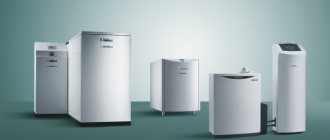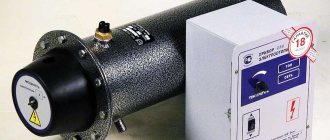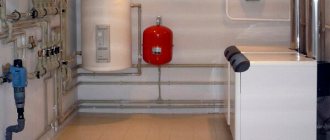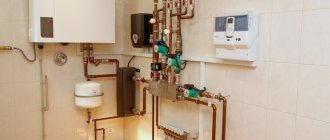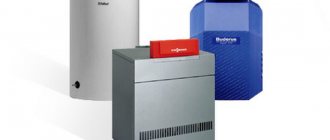- We offer to buy wall-mounted gas double-circuit boilers with delivery in the Tavago online store.
- Price for wall-mounted gas double-circuit boilers from 28,322 rubles.
- Read instructions and reviews about Wall-mounted gas double-circuit boilers.
The boiler is the central element of any heating system, and if you want to purchase a high-quality gas double-circuit wall-mounted boiler, then you can consider that you have come to the right place. We will offer you the best gas boilers from the world's leading manufacturers. Only the best prices, only positive reviews and a huge selection are already waiting for you in our catalog!
What are turbocharged gas boilers?
A turbocharged gas boiler is a unit responsible for heat supply, which is additionally equipped with a forced air exchange system. Due to this feature, it does not require the construction of a full-fledged smoke shaft, since communication with the external environment occurs through a coaxial chimney.
A coaxial chimney is a continuous structure (usually included with the boiler), consisting of pipes of different diameters, nested one inside the other. Oxygen is taken in through the external channel (large pipe), and waste combustion products are discharged through the central channel (smaller pipe).
Since turbo boilers do not need high-quality ventilation of the room itself, they can be installed both in private houses and in city apartments.
The main and, perhaps, the only significant disadvantage is that due to the presence of a turbine and more complex automation, they are extremely energy dependent.
Design and principle of operation
The basic structure of a turbo boiler is not much different from its predecessor, but the presence of auxiliary components makes some changes to its design.
The air necessary to maintain combustion comes from the street directly into the closed combustion chamber. Since it is isolated from the living space and directly connected only to the coaxial chimney, this completely eliminates any influence of exhaust gases on the internal microclimate.
Design of a floor-mounted turbocharged model.
A fan (turbine) removes smoke outside the house without the use of exhaust fans, creating excess pressure (turbocharging).
The rotation speed of the turbine fan is adjusted automatically, so even when the gas pressure in the line decreases, the composition of the gas-air mixture remains optimal. When changing power, the speed is instantly selected to provide the required amount of air and proper traction. In this way, the best conditions for burner operation are maintained, allowing the greatest amount of energy to be obtained from the fuel.
How to choose a room thermostat and save up to 30% per month on heating
Aspirated or turbocharged: which is better?
A traditional atmospheric boiler has an open combustion chamber: air for gas combustion is taken from the room. This means that the spent oxygen must be completely replaced with new oxygen. This requires supply and exhaust ventilation.
Without organizing good supply and exhaust ventilation, normal operation of an atmospheric gas boiler is impossible. Firstly, the fuel will not be able to burn completely and, as a result, the coolant will lose some amount of heat, and secondly, life-threatening carbon monoxide (CO) - carbon monoxide - will form in the room.
Therefore, for small buildings, where it is problematic to select a ventilated boiler room with a vertical chimney separate from the living area, it is better to choose a turbocharged boiler. And for gas heat supply of small retail spaces, offices and standard high-rise buildings, it is generally the only option.
Types by type of smoke removal and which one is better?
There are two types of smoke removal systems:
- Open (atmospheric). It works on the principle of stove draft; smoke is removed through a common house or its own vertical chimney.
- Closed (turbocharged). The smoke is forced out by the turbocharger fan.
Natural cravings are unstable and depend on many external factors. Sometimes a reverse draft occurs, which, instead of removing the smoke, begins to draw it indoors.
Turbocharged boilers are completely free of such problems and demonstrate a stable smoke removal regime in any conditions. This makes the choice of atmospheric installations less attractive, however, all non-volatile boilers operate on this principle.
In order to get rid of possible problems, external additional devices are used - turbo nozzles.
They help stabilize and equalize the smoke removal regime, although they can only work if there is a power supply.
Reviews of household models with forced air exchange: advantages and disadvantages
According to reviews from owners of turbocharged gas boilers, the following pros and cons can be identified:
| Advantages | Flaws |
| safety - the tightness of the closed combustion chamber virtually eliminates the risk of smoke entering the room | high cost - prices for wall-mounted models are higher by 20-30%, for floor-mounted ones - by 20-50%, but you can eliminate the cost of building a full-fledged chimney |
| free placement - air intake from the street allows you to install the boiler in very small rooms (of course, meeting the requirements) | constant noise - the active operation of all turbo boilers is inevitably accompanied by a monotonous sound of fan rotation, its volume depends on the model, as well as the presence of a sound insulation layer in the boiler |
| simple installation of the chimney - to output the coaxial pipe, just make a hole (Ø 110) in the outer wall of the house | Volatility dependence - any problems with voltage (interruptions, non-compliance with the norm) cause the fan to stop |
| low fuel consumption - efficiency is achieved due to automation, which controls the turbine rotation speed |
Difficulties with energy supply can be easily avoided by connecting a voltage stabilizer and a backup power source to the turbocharged boiler - an electric generator (gasoline, diesel) and an uninterruptible power supply (UPS). However, it must be taken into account that this will lead to additional material investments.
Operational safety
Despite the safety of a double-circuit gas turbo boiler, any equipment can fail, so if a gas smell appears in the room, the following precautions must be taken:
- Immediately open the windows and ventilate the room;
- Close the ball valve on the gas supply line;
- You should not turn on lights or electrical appliances in the room, or use mobile phones;
- Call the emergency gas service.
Piping of a turbocharged double-circuit gas boiler Baxi ECO Four.
Important! The design of a turbocharged boiler almost completely eliminates gas from entering the room, however, despite this, it is recommended to organize additional ventilation in the room where the boiler is installed. This applies to all gas-powered equipment.
How to choose a turbocharged gas boiler for heating a private home
Wall or floor
Wall-mounted models fit perfectly into the kitchen interior or can be completely hidden in a closet.
- floor-mounted ones are more versatile and durable, since the design is unlimited in weight; they often have durable cast iron heat exchangers installed.;
- mounted (wall-mounted) - compact and lightweight, medium and low power (10–50 kW) boiler units, often having greater efficiency than floor-standing models. However, due to weight requirements, they use less corrosion-resistant steel and copper heat exchangers.
In addition, wall-mounted boilers contain all the necessary heating system modules in one housing (expansion tank, circulation pump, safety valve, air vent, etc.), which not only simplifies, but also makes installation cheaper. Floor-standing models are rarely equipped with all the necessary modules.
Single-circuit or double-circuit
The functionality of a turbo boiler is determined by the number of circuits:
- single-circuit - its capabilities are limited exclusively to heating;
- double-circuit - along with heating, it heats water for domestic needs.
A double-circuit boiler is a combination of a boiler and a flow-through heater, i.e. heating of the room stops while hot water is supplied. It is worth clarifying that, contrary to popular belief, the coolant does not have time to cool down during downtime, so the temperature in the home remains unchanged.
Of course, the cost of the double-circuit option is 10–30% higher, but it is still more profitable than organizing hot water supply in any other way, for example, using a boiler and a single-circuit boiler. And if necessary, one of the circuits can be turned off - for example, in the summer, when there is no need to heat the home.
Heat exchanger type and material
A copper heat exchanger is the most optimal option for a wall-mounted model.
The heat exchanger material affects the durability of the boiler:
- cast iron (service life 25–30 years or more) is the most heat- and corrosion-resistant metal, but fragile and heavy, therefore it is used only in floor-standing models;
- copper (service life 12–17 years) is a very light and thermally conductive metal (it heats up and cools down quickly), is slightly susceptible to corrosion, but can burn out.
- steel (service life 10–15 years) - metal tolerates transportation well, because it is not sensitive to physical impact, lightweight and inexpensive to produce, but is prone to rust, which leads to leakage over the years.
Double-circuit boilers are also divided according to the type of heat exchanger: separate (one for each circuit) and dual - bithermic (the hot water circuit passes through the main heat exchanger). The latter option is cheaper, but it is less reliable, because the scale formed in it is almost impossible to clean, and it is clogging with scale that often becomes the cause of premature failure.
Efficiency
Despite the fact that the “pure” efficiency of the atmospheric (90–92%) and turbo boiler (92–95%) is almost the same, the second will have higher gas consumption efficiency.
The point is in using a coaxial chimney: when cold air from the street enters its external cavity, it begins to heat up even before entering the combustion chamber from the heat of the smoke (100–130 °C), which exits through the internal cavity of the same pipe. Therefore, less resources are spent on further heating. It’s also worth adding more efficient control of air flow and draft, which also affects gas consumption.
Minimum required power
You can calculate the required power of a turbo boiler using a simple formula: where 1* kW of energy is consumed per 10 m2 of heated area.
* heat loss of an average residential property with ceilings up to 2.7 m from central Russia.
For example, for a standard house in the Moscow region with a masonry of 2 bricks and a ceiling height of 2.7 m, with an area of 120 m2, the minimum suitable power of a turbo boiler will be Q = 120 ÷ 10 × 1 = 12 kW.
We recommend setting aside a margin of 15–20% of this value so as not to operate the unit at the limit, so for the same object Q≈14–15 kW.
Also, if we consider a two-circuit model, then we will have to add at least 15–20% for the use of hot water supply, so in total it will turn out that Q≈16–17 kW. It is also important not to overdo it with power, otherwise the boiler will “clock” too often (turn on and off), which will reduce its resource.
How to accurately calculate the required boiler power Individual calculation, formula and correction factors
Types of atmospheric heating devices
The equipment differs in:
- efficiency;
- power;
- sizes;
- mass.
Wall-mounted atmospheric units are characterized by a maximum power of 36 kW. On average, the power of open-type heating equipment is 20-60 kW.
Wall-mounted atmospheric gas boilerSource malivice.ru
The optimal power of the heating device is determined taking into account the area and volume of a particular room, as well as probable energy losses, such as: the number of windows, non-insulated walls, and floor design features. It is worth giving preference to models that can heat a room with an area that is 25% larger than the actual one. The heater must produce 10 kW of energy per 100 square meters; 25% must be added to this amount; this energy will be used to heat the required volume of hot water, and the added 20% will ensure the normal functioning of the unit during peak loads.
Efficiency shows the amount of energy, part of which is spent on heating water, the other part is burned. The efficiency of atmospheric gas boilers is on average 80-90%, but there are also more expensive models with an efficiency of up to 97%. Condensing boilers have an efficiency rate of 100%.
Equipment intended for placement on the floor surface is characterized by a large weight of about 100 kg. Installation of this structure is labor-intensive and high financial costs. Installation of larger models requires a separate foundation. A significant disadvantage of the floor-standing unit is the lack of a water heating function. Floor-standing boilers are noisy, and the chimney must be cleaned periodically. The advantages include increased power characteristics, extended service life, and lack of electronics.
Atmospheric boiler designed for placement on the floor Source stat-klimat.ru
Equipment intended for placement on the wall is smaller in size, weighing no more than 50 kg. Wall-mounted boilers do not take up much space and are easy to install; they are used to equip the heating system of small apartments and houses. Such models of gas equipment allow combustion products to be removed through the chimney system or directly through the wall. The disadvantages include the dependence of the unit’s operation on electronics. If one of the elements fails, a complete system shutdown will be required. The high cost of the equipment determines the size of the repair cost; this value can be a third of the cost of a new boiler.
The design capabilities of atmospheric heating units make it possible to divide them into: single-circuit and double-circuit.
Single-circuit gas boiler in the boiler roomSource koffkindom.ru
Single-circuit ones are used for heating, and double-circuit ones provide heating and water heating. It is allowed to connect an indirect heating boiler to a single-circuit unit. A double-circuit device, compared to a single-circuit device, has a higher cost and a complex operating system.
Construction of an atmospheric gas boilerSource otsplus.by
A double-circuit unit is not a full-fledged boiler; in order for the system to work, strong water pressure is required, for this purpose the equipment is placed in close proximity to the bathroom or kitchen.
The best known manufacturers and models: characteristics and prices
BAXI ECO-4s 24F
The Italian double-circuit turbo boiler with a power of 24.0 kW was designed taking into account the specifics of Russian conditions, so it is adapted to work with low gas pressure, power outages and other unstable indicators. It also has one of the best efficiency in its price segment - 92.9%, gas consumption - 2.54 m3/h. The primary heat exchanger is made of copper.
The owners note almost silent operation; after using it for more than 5 years, there were no serious service complaints.
Manufacturer: BAXI (BAKSI), Italy.
Vaillant turboTEC pro VUW 242/5-3
Double-circuit model from the reference German brand with a power of 24 kW. It is particularly reliable and durable due to excellent build quality, the use of high-tech alloys and the best materials. Efficiency 91%, maximum gas flow 2.80 m3/h. It also features a copper primary heat exchanger, a modulating burner, functional automation with many safety systems and a pleasant, stylish design.
Manufacturer: Vaillant (Vailant), Germany (assembled in Slovakia).
Viessmann Vitopend 100-W A1HB001
One of the best gas turbocharged boilers for heating a private home and another reference German model with a capacity of 24 kW. Like the previous Vaillant turboTEC, it is highly reliable and durable, while the boiler is absolutely not demanding on the quality of the coolant and the pressure in the gas line. Efficiency – 91%, maximum gas flow – no more than 2.77 m3/h.
A serious advantage is the presence of a programmer that allows you to set the boiler operation settings for the next day or week, for example, setting the temperature to 15°C during working hours when the owners are not at home, which will significantly reduce operating costs.
The only common problem is the boiler turning off due to icing of the chimney at frosts below -17-18°C. The solution is to monitor the condition of the chimney and promptly remove ice, insulate its outer part or install an anti-icing structure.
Manufacturer: Viessmann (Wisman), Germany.
Buderus Logamax U072-24
Wall-mounted turbocharged gas boiler with a power of 24.0 kW. In fact, this is another reference German model, but with Russian localization, which made it possible to significantly reduce its cost and distinguish it from analogues. Efficiency – 92%, maximum fuel consumption – 2.8 m3/h. The boiler is also equipped with a copper primary heat exchanger and a modulated burner.
The only drawback is the lower Russian build quality, which is not typical for other German and Italian models.
Manufacturer: Buderus (Buderus), Germany-Russia.
Navien GA 23KN
A floor-standing double-circuit turbo boiler with a power of 23.0 kW has a modest gas consumption of 2.24 m3/h. It is equipped with unique protection against voltage surges: with a difference of ± 30%, the SMPS chip on the microprocessor is activated, which allows you to continue working without the risk of damaging the electronics. At the same time, the boiler is equipped with a modulating burner, a programmer, and a room thermostat and remote control are already included in the factory configuration.
Notable disadvantages are the steel heat exchanger, mediocre build quality, and noisy operation relative to the above models.
Manufacturer: NAVIEN (NAVIEN), South Korea (often with Russian assembly).
Types of turbo boilers
There are 2 types of devices available:
- convection;
- condensation
It is known from physics that a substance gives or absorbs the greatest amount of energy when its state of aggregation changes.
Condensing boilers only work with “warm floors” and other low-temperature systems. The moisture formed in the heat exchanger is an acidic solution, therefore it is not allowed to be drained into an autonomous sewer system - this will lead to the death of bacteria. It is necessary to dispose of the condensate separately or first neutralize it with alkali. This ban does not apply to centralized sewerage.
Heaters also differ in heat exchanger material. Available options:
- steel;
- silumin (an alloy of aluminum and silicon);
- cast iron;
- copper.
The first 2 metals are used in budget boilers. It is not recommended to purchase models with silumin heat exchangers. They do not last long and fail abruptly - they crack.
Copper products, due to their good thermal conductivity, contribute to increased efficiency. But at the same time, they are more expensive than all other options.
Cast iron heat exchangers are the most durable and at the same time have a low price. Their disadvantage is their large mass.
According to the installation method, heaters are divided into types:
- wall or hanging;
- floor
The advantage of models of the first type is that they do not take up space on the floor. Such a device can be installed in the kitchen between cabinets, and it will not interfere. But it also has disadvantages due to its low weight:
- Power does not exceed 30 kW. This is enough for most apartments and houses.
- They install either the cheapest and short-lived steel heat exchanger, or an expensive copper one. Cast iron is too heavy for a wall-mounted boiler.
The type of burner matters. A boiler with a simple 1-stage device operates in start-stop mode, which negatively affects its service life. A modulated burner with the ability to adjust power over a wide range (10%-100%) does not have this drawback. Having selected the desired heat output, the heater reaches a stable mode, using less gas.
Prices: summary table
Comparative rating of popular turbocharged gas boilers:
| Unit model | Efficiency, % | power, kWt | DHW, l/min. | Flow, m3/h | price, rub. |
| BAXI ECO-4s 24F | 92,9 | 24 | 13,7 | 2,54 | 43 500 |
| Vaillant turboTEC pro VUW 242/5-3 | 91 | 24 | 11,5 | 2,80 | 76 000 |
| Viessmann Vitopend 100-WA1HB001 | 91 | 24 | — | 2,77 | 51 000 |
| Buderus Logamax U072-24 | 92 | 24 | — | 2,80 | 37 500 |
| Navien GA 23KN | 91,5 | 23 | 13 | 2,24 | 40 500 |
What to look for when choosing a device
Turbocharged and atmospheric boilers are selected according to power
When choosing methane boiler equipment, the first step is to determine the thermal power that will be sufficient to heat a particular building. The standard ceiling height of up to 3 meters with average insulation of the external wall assumes the consumption of thermal energy per 10 square meters within 1 kW. You also need to consider:
- A single-circuit boiler is designed for heating only. To have hot water in the tap, you need a double-circuit one.
- Devices with copper heat exchangers have proven themselves well - they are durable and heat up quickly.
- For running models it will always be possible to find components and a service center for maintenance.
